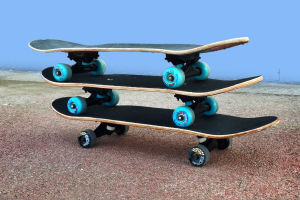Pick Your Perfect Surfboard
Choosing a surfboard can be overwhelming for beginners and seasoned surfers alike.
There are countless styles, shapes, and sizes to pick from, and each is uniquely designed to match specific skill levels and wave conditions.
Let's dive into how to find the right surfboard for your abilities, preferences, and wave-riding goals.
Understanding Surfboard Types
Different boards are suited to different skills, styles, and wave sizes. Here's a quick breakdown:
Shortboards
Shortboards are the go-to for experienced surfers. These boards are usually under 7 feet long, featuring a pointed nose and narrow shape that allows for fast, dynamic turns on waves. However, they require a high level of balance and control, making them tough for beginners.
Longboards
Longboards, often 8 to 12 feet long, are ideal for beginners or surfers who enjoy a more relaxed, cruisy style. They offer greater stability and are easier to paddle, making them perfect for catching smaller waves. For novices, longboards are a fantastic starting point.
Funboards
Funboards are a blend between shortboards and longboards. They usually range from 7 to 8 feet, offering more maneuverability than longboards while still maintaining a fair amount of stability. These are ideal for intermediate surfers or beginners looking to transition into smaller, more agile boards.
Fish Boards
Fish boards are shorter but wider and thicker than standard shortboards, providing excellent stability and buoyancy. They work great in small to medium waves and are suitable for intermediate surfers looking to add more maneuverability without sacrificing too much stability.
Matching Board Size with Skill Level
The size of your board will significantly impact your surfing experience. A larger board offers more stability and is generally easier to paddle, while smaller boards provide increased maneuverability but require more skill.
Beginners
If you're new to surfing, prioritize stability and paddle power. Opt for a board at least 8 feet in length. Longboards and soft-top boards are usually best for beginners, as they make it easier to catch waves and stay balanced. Avoid shortboards as they can be challenging for those still learning the basics.
Intermediate Surfers
Once you've mastered the basics, you might want to experiment with shorter, more agile boards. A funboard or fishboard will give you more maneuverability while still providing enough stability to feel confident. Boards in the 7-8 foot range are often ideal for intermediate surfers.
Advanced Surfers
If you're experienced and looking to take on bigger, faster waves, a shortboard in the 5-7 foot range could be your best choice. Shortboards allow for quick, sharp turns and are better suited for steep waves. Since they require excellent balance and control, they're typically best left for those who have a solid skill foundation.
Considering Wave Conditions
Different boards perform best in specific wave conditions, so it's worth thinking about the type of waves you're likely to encounter.
Small Waves
For smaller, less powerful waves, a larger board with more volume—like a longboard or a fish board—is ideal. These boards provide the extra float you need in waves that might otherwise be too weak to ride effectively.
Medium Waves
For medium-sized waves, funboards and shortboards work well. They provide a good mix of speed and control, allowing you to catch waves with ease while still performing sharp turns.
Large Waves
If you're experienced and tackling larger waves, shortboards are usually the go-to. They're designed to handle high-speed drops and rapid turns, which makes them well-suited for challenging, powerful waves.
Board Material and Construction
Another factor to consider is the board's material. There are three primary types:
Foam Boards
Foam boards are great for beginners. They're softer and more forgiving than fiberglass boards, reducing the chance of injury. Foam boards are stable and easier to paddle, ideal for learning the basics.
Epoxy Boards
Epoxy boards are lightweight, durable, and offer added buoyancy, making them ideal for smaller waves. They're a solid choice for beginners and intermediate surfers looking for durability and easier maneuverability.
Fiberglass Boards
Fiberglass boards are traditional surfboards, providing a good balance of weight and flexibility. They're great for more advanced surfers who prioritize responsiveness and performance, but they can be more fragile than epoxy boards.
Additional Tips for Board Selection
Think About Your Body Size
Your height and weight should be taken into account when choosing a surfboard. Larger surfers generally need a board with more volume to stay buoyant, while smaller surfers can handle smaller boards without difficulty.
Don't Rush the Transition
If you're a beginner, don't feel pressured to switch to a shorter board too soon. Mastering a longboard or funboard will make it easier to progress to a smaller board later.
Consider Renting Before Buying
Trying out different boards can help you discover what feels right before committing to a purchase. Many surf shops offer rentals or demo days, allowing you to test different shapes and sizes.
Choosing the right surfboard isn't just about grabbing the trendiest design; it's about finding one that complements your skill level, size, and the waves you're riding. The right board can elevate your surfing experience, making each wave ride more enjoyable.
Choose the BEST Beginner surfboard for you | Sideways Surf Guide
Video by Sideways


